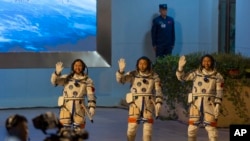ຍານອະວະກາດຂອງຈີນ ທີ່ບັນທຸກນັກບິນອະວະກາດສາມຄົນ ໄດ້ເຂົ້າຈອດກັບ ສະຖານີອະວະກາດຂອງຕົນທີ່ບິນຢູ່ໃນວົງໂຄງຈອນຂອງໂລກ ໃນວັນອັງຄານ ວານນີ້ ໃນຂະນະທີີ່ປະເທດພວມຫາທາງຂະຫຍາຍການສຳຫຼວດນອກອະວະ ກາດ ອັນເປັນການແຂ່ງຂັນກັບ ສະຫະລັດ ແລະແມ່ນກະທັງເປັນການສະ ແຫວງຫາການຮ່ວມມືຈາກປະເທດອື່ນໆນຳດ້ວຍ ອີງຕາມລາຍງານຂອງອົງ ການຂ່າວເອພີ.
ທີມນັກບິນອະວະກາດ ທີ່ມີຊາຍສອງຄົນ ແລະຍິງຄົນນຶ່ງ ຈະສັບປ່ຽນບັນດານັກ ບິນອະວະກາດ ຜູ້ທີ່ໄດ້ອາໄສຢູ່ໃນສະຖານີອະວະກາດ ທຽນກົງ ມາໄດ້ຫົກ ເດືອນຜ່ານມາແລ້ວນັ້ນ ແລະຈະດຳເນີນການທົດລອງຫລາຍຢ່າງ ແລະ ບູລະນະຮັກສາໂຄງສ້າງຂອງສະຖານີອະວະກາດນຳດ້ວຍ.
ພວກເຂົາເຈົ້າ ຄາດໝາຍວ່າ ຈະອາໄສຢູ່ສະຖານີອະວະກາດຈົນຮອດເດືອນ ເມສາ ຫຼື ພຶດສະພາ ຂອງປີໜ້າ. ຜູ້ບັນຊາການພາລະກິດໃໝ່ນີ້ ແມ່ນທ່ານ ກາຍ ຊູຍຊີ (Cai Xuzhe) ຜູ້ທີ່ໄດ້ຂຶ້ນໄປອະວະກາດໃນພາລະກິດ ເຊິນຊູ-14 ໃນປີ 2022, ໃນຂະນະທີ່ອີກສອງຄົນ ຄື ທ່ານຊົງ ລິງດົງ ແລະທ່ານນາງ ຫວັງ ຮົວຊີ ນັ້ນ ແມ່ນເປັນຄັ້ງທຳອິດໃນການເດີນທາງໄປຍັງອະວະກາດ. ທັງທ່ານຊົງ ແລະ ທ່ານນາງ ຫວັງ ເກີດໃນຊຸມປີ 1990 ແລະໄດ້ສຳເລັດ ການຮັບສະໝັກເປັນນັກບິນອະວະກາດລຸ້ນທີສາມຂອງຈີນ ໂດຍຜ່ານການ ທົດສອບຢ່າງເຂັ້ມງວດ ແລະຂັ້ນຕອນຂອງການຝຶກອົບຮົມທີ່ໃຊ້ເວລາຫຼາຍປີ.
ເມື່ອຕອນເຊົ້າວັນພຸດມື້ນີ້ ຈີນໄດ້ປະກາດກ່ຽວກັບການສົ່ງຈະຫຼວດຂຶ້ນ ແລະ ເຂົ້າສູ່ນອກຊັ້ນອະວະກາດ “ສຳເລັດຢ່າງສົມບູນ.”
ຍານອະວະກາດພາລະກິດ ເຊິນຊູ-19 ທີ່ບັນທຸກນັກບິນອະວະກາດສາມຄົນ ໄດ້ຖະຍານຂຶ້ນອອກຈາກສູນກາງຖານປ່ອຍຍານ Jiuquan ທາງພາກຕາເວັນ ຕົກສຽງເໜືອ ຂອງຈີນ ໃນຕອນເຊົ້າເວລາ 4 ໂມງ 27 ນາທີ ຕາມເວລາ ໃນທ້ອງຖິ່ນ ທີ່ຕິດຕັ້ງຢູ່ເທິງຈະຫຼວດ Long March-2F ອັນເປັນສັນຫຼັງ ຂອງພາລະກິດທີ່ບັນຈຸນັກບິນອະວະກາດຂອງຈີນນັ້ນ.
ຜູ້ປະກາດຂ່າວຂອງໂທລະພາບແຫ່ງຊາດຂອງຈີນ ໄດ້ປະກາດວ່າ “ສະພາບ ການຂອງນັກບິນອະວະກາດ ແມ່ນດີ ແລະການສົ່ງຂຶ້ນໄດ້ບັນລຸຜົນສຳເລັດ.”
ຈີນ ໄດ້ສ້າງສະຖານີອະວະກາດດ້ວຍຕົນເອງ ຫຼັງຈາກທີ່ຖືກກີດກັນບໍ່ໃຫ້ເຂົ້າ ຮ່ວມໃນສະຖານີອະວະກາດສາກົນ ສາເຫດຫຼັກຍ້ອນຄວາມເປັນຫ່ວງຕ່າງໆ ຂອງ ສະຫະລັດ ກ່ຽວກັບກອງທັບປົດປ່ອຍປະຊາຊົນຈີນ, ການຄວບຄຸມໂດຍ ລວມດ້ານອາວຸດຂອງກອງທັບ ແລະໂຄງການວະກາດ ໂດຍພັກຄອມມິວນິສ ຈີນ. ໂຄງການດວງຈັນຂອງຈີນ ເປັນສ່ວນນຶ່ງຂອງການເປັນຄູ່ແຂ່ງທີ່ເພີ້ມຂຶ້ນ ນັບມື້ກັບສະຫະລັດ ແລະປະເທດອື່ນໆ ລວມທັງ ຍີ່ປຸ່ນ ແລະອິນເດຍ.
A Chinese space ship carrying a three-person crew docked with its orbiting space station Tuesday as the country seeks to expand its exploration of outer space in competition with the United States, even as it looks for cooperation from other nations.
The team of two men and one woman will replace the astronauts who have lived on the Tiangong space station for the last six months, conducting a variety of experiments and maintaining the structure.
They are expected to stay until April or May of next year. The new mission commander, Cai Xuzhe, went to space in the Shenzhou-14 mission in 2022, while the the other two, Song Lingdong and Wang Haoze, are first-time space travelers. Song and Wang were born in the 1990s and are graduates of the third wave of Chinese astronaut recruitment, having undergone a rigorous testing and training process taking years.
Early Wednesday morning, China declared the launch and entry into outerspace a “complete success.”
The Shenzhou-19 spaceship carrying the trio blasted off from the Jiuquan Satellite Launch Center in northwest China at 4:27 a.m. local time atop a Long March-2F rocket, the backbone of China’s crewed space missions.
“The crew condition is good and the launch has been successful,” the state broadcaster China Central Television announced.
China built its own space station after being excluded from the International Space Station, mainly because of U.S. concerns over the People’s Liberation Army, the Chinese Communist Party’s military arm’s overall control over the space program. China’s moon program is part of a growing rivalry with the U.S. and others, including Japan and India.






ຟໍຣັມສະແດງຄວາມຄິດເຫັນ